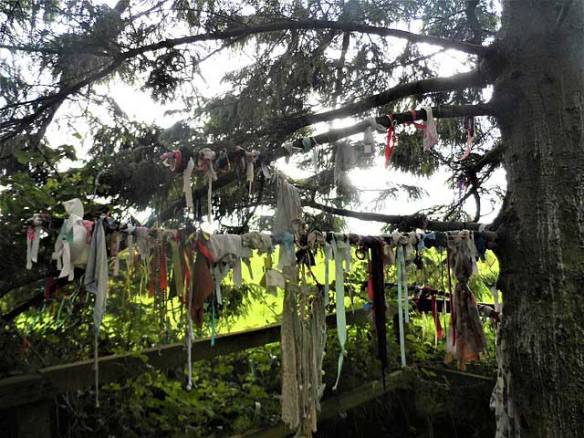The following article was first posted at Waterton’s Walton.

Image Attribution: Clootie tree, Kildare. By Sheila1988 – Own work, CC BY-SA 4.0, Link
When people think of local history, they often focus on the more recent past. But what happens if a place has been occupied for much longer?
The Wikipedia entry for Walton refers to a Rag Well as follows:
“In the past, Walton was famous for its ‘rag well’, which was said to cure eye ailments if the afflicted tied strips of cloth to a tree above the well.”
The stated source of this information is page 354 of Russell Ash’s (1973) Folklore, Myths and Legends of Britain.
The thing is though, no one appears to have heard about this feature of Walton’s past. If there was indeed a ‘Rag Well’ in the village it must have existed many generations ago far beyond living memory.
Intrigued by this potential component of Walton’s history I did a bit of online research and came across a feature called a Clootie Well. Like the rag well, a Clootie Well is a spring or well beside by a tree on which strands of cloth are hung to cure ailments or make some specific wish come true. It seems that this sort of practice was once quite common in Celtic parts of the British Isles, with many such features currently visible in Scotland and Ireland (like the image at the top from Kildare). It is a tradition that is thought to go right back to the Ancient Britons.
This got me thinking about the name ‘Walton’ and what such a name implies about its history.
Walton gets its name from an Anglo-Saxon word that referred to a village populated by Welshmen. The Welsh of course were the Celtic Ancient Britons who inhabited our Northern European island at the time of the Roman conquest. The origin of the word ‘Briton’ derives from the word Priteni which described this people because they tattooed themselves with blue woad.
As the Anglo Saxons invaded progressively from the east after the fall of the Roman Empire, the Welsh inhabitants of the island were driven progressively westwards. At some point Walton would have been a border village, or Welsh enclave, between an expanding Anglo Saxon England and a Wales long before Wales was compelled to accept its current more limited boundaries.
This could mean that Walton has its origins in ancient or even prehistoric times.
Walton has certainly had its share of wells in the past and there are many springs. There is a spring that is still visible in Haw Park woods which is known as the Fox Well.
I understand that Cherry Tree estate was built in an area of numerous springs. I was told that one of the bungalows was, in fact, built on top of a spring that flooded its living room before remedial works had been completed. I also hear that there is a spring near the allotments; indeed water does drain from that direction into the ditch that takes water towards the Jubilee playing field and then on to Brookland’s beck. This water looks a bit rusty as it comes from the direction of the allotments, probably the result of industrial era contamination. I am also told that there was a well at the site of Soap House Yard.
Could any of these be the location of the fabled rag well? It would be interesting to find out more about this potential evidence of Walton’s antiquity.
